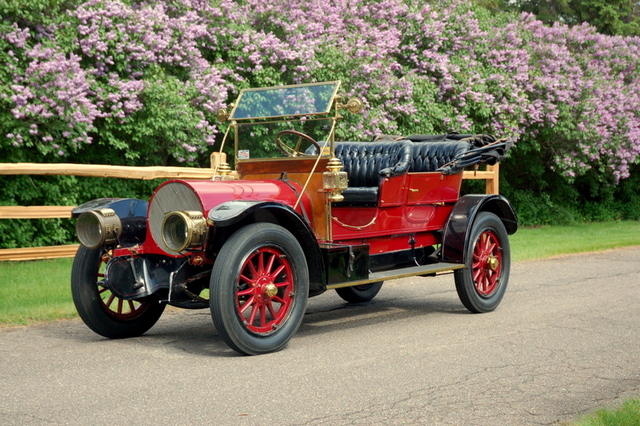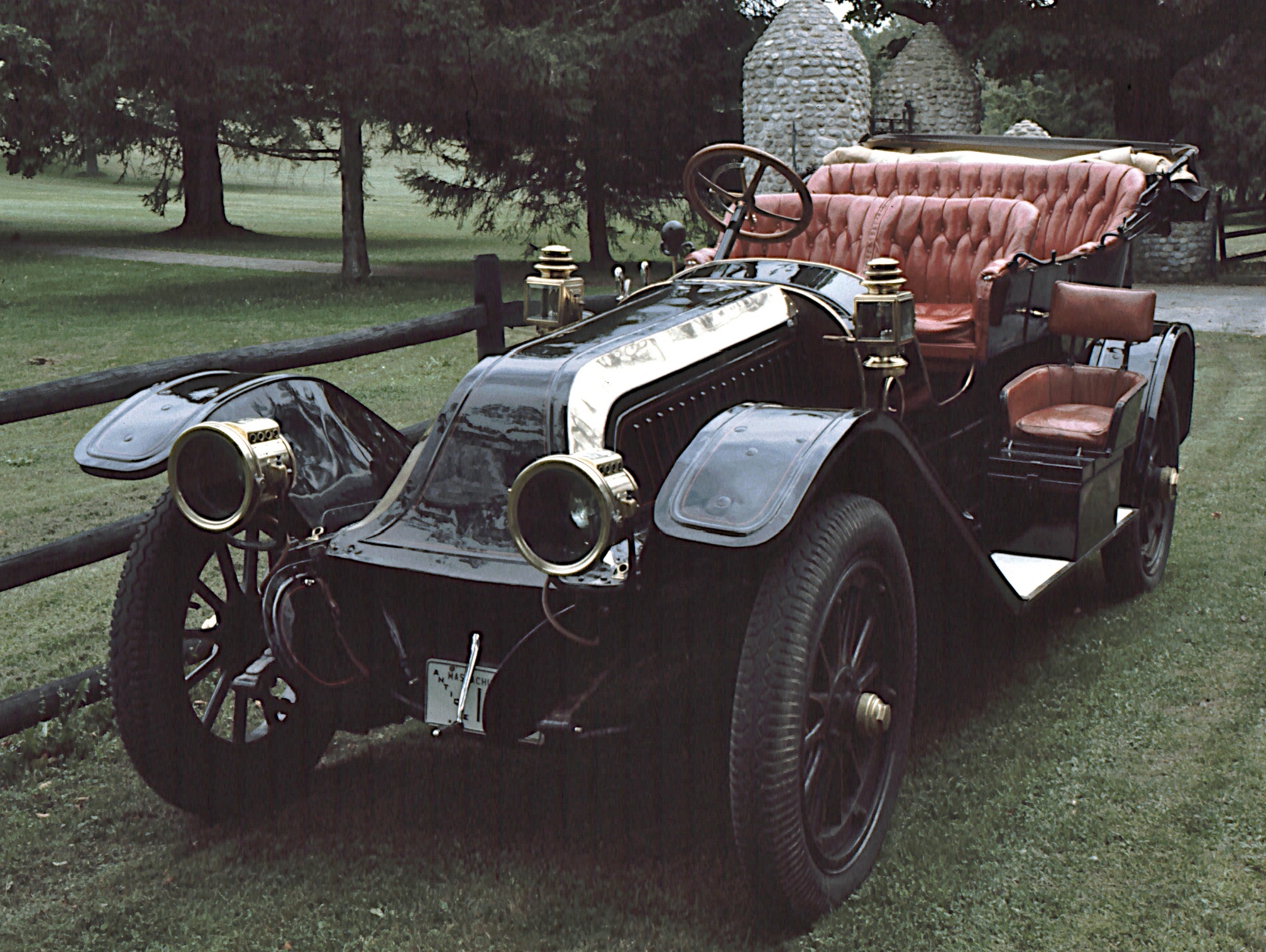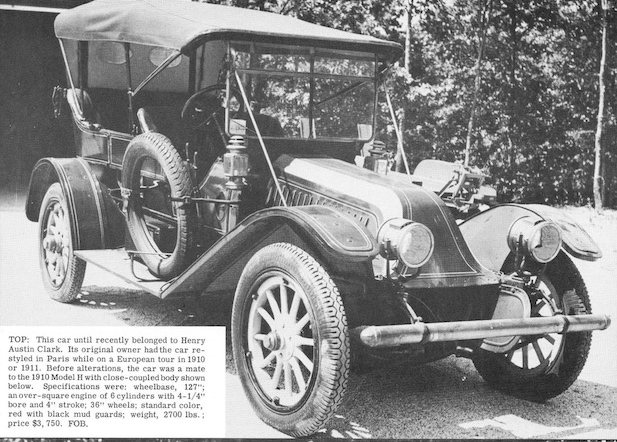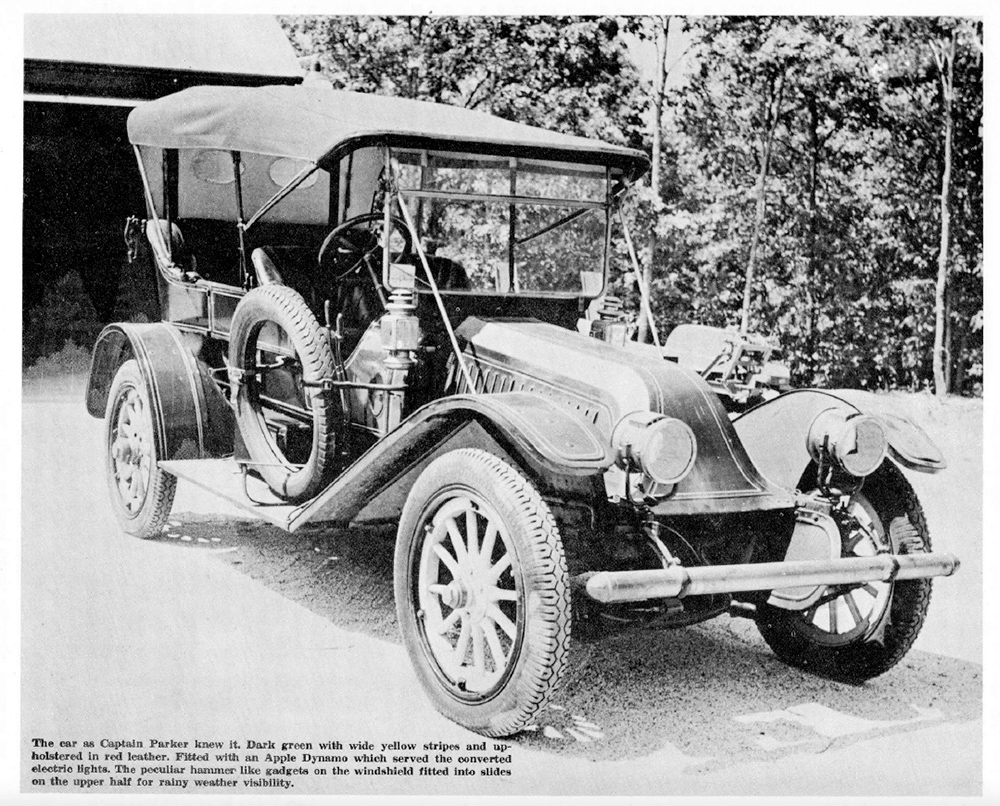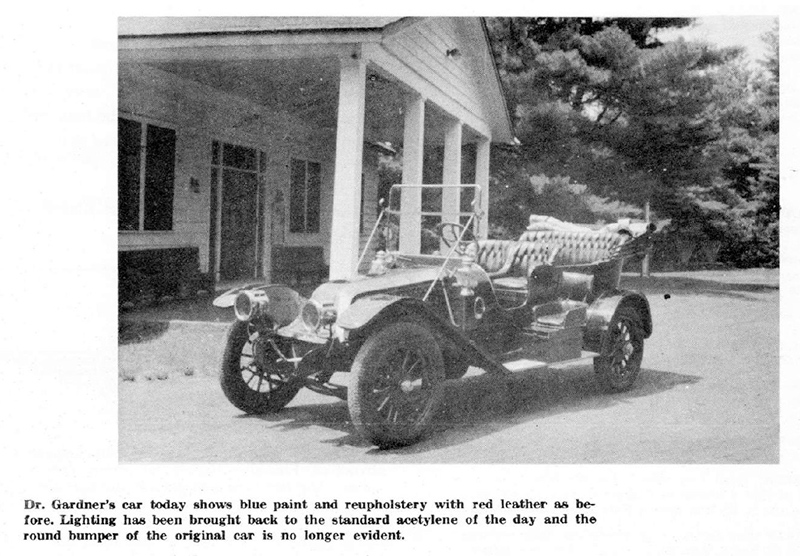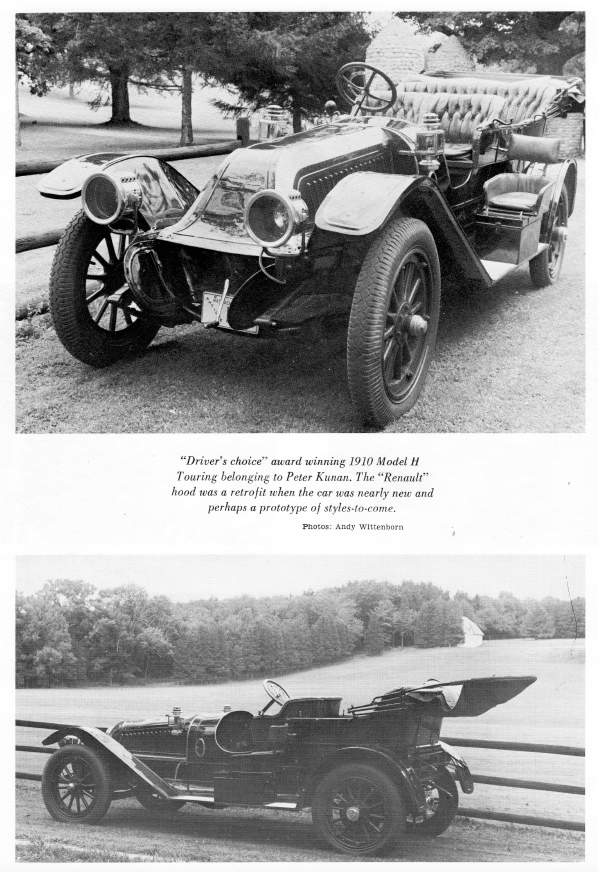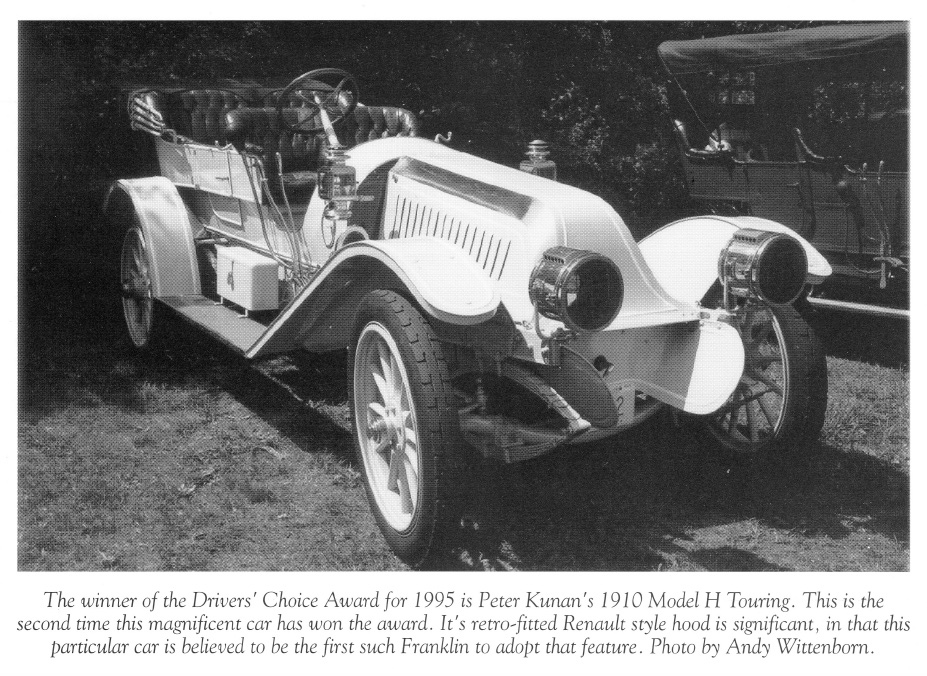1910 Model H Custom Touring - Body by Derham
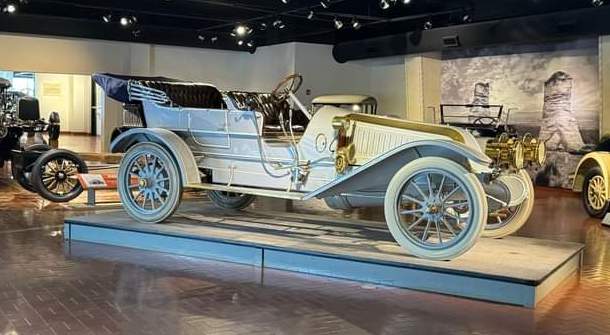
This car is one of ≈400 Model H Franklins out of a total of ≈2,000 built in 1910. 4 are known to still exist.
The Model H was the largest of three models of passenger cars offered by the Franklin Company in 1910. It has a six cylinder engine of 4 l/4" bore by 4" stroke displacing 340 cu.in. and producing 42 hp.
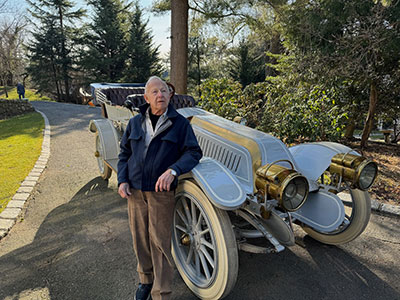
|
This car was generously donated to the Franklin Automobile Collection at Hickory Corners (FACHC) by Sam and Emily Mann of Englewood, New Jersey. |
It was picked up and delivered to the Franklin Automobile Colletion at Hickory Corners on a very cold (-4°F / -20°C) Monday morning in January 2024, unloaded from the truck, towed up to the Franklin Museum, pushed inside, and placed up on the pedestal in the center of the room.
This unique car has a long history with the H. H. Franklin Club, Inc. and most of its previous owners are known. First known information about the car was published in 1953 in the Air Cooled News (Air Cooled News, or ACN, is the publication of the H. H. Franklin Club, Inc.)(ACN-003). A note from Henry Austin Clark of the Long Island Automotive Museum on Long Island, New York, that he had recently sold the 1910 Franklin 48hp Touring car to Mr. Anthony J. Kovelseki of 315 Adams Ave., Scranton, Pa. "This was the prototype of the shovel-nosed car, being altered in France, and later copied by Franklin for the 1911 cars." Click here to view the ACN article.
ACN #8 of August 1955 contained a photo of the car in its first modified form noting that the car recently belonged to Henry Austin Clark. It shows the car with the "shovel-nose" hood on it, but still carrying the original cowl. "This car until recently belonged to Henry Austin Clark, Its original owner had the car re-styled in Paris while on a European tour in 1910 or 1911. Before alterations the car was a mate to the 1910 Model H with close-coupled body shown below. Specifications were: wheelbase, 127"; an over-square engine of 6 cylinders with 4-1/4" bore and 4" stroke, 36" wheels, standard color, red with black mud guards, weight, 2700lbs.; price $3,750. FOB"
Air Cooled News #30 of December 1962 revealed more information about the car, with the publishing of two letters from Chas Parker of Williamston, Michigan, written to Dr D S Gardner of Scranton, Pa in 1954 and 1955
July 31, 1954 Dear Dr. Gardner Your nice note regarding the old 1910 Franklin car was a long time reaching me and, to, a great surprise for I thought the old Franklin was junked years ago. I will be very much interested in knowing how you every found out where I was or that I ever had anything to do with it. Just a wild guess it may have been Edgar Scott of Bryn Marr, Pa., that knew I went to 44 Sevilla St., St. Augustine, Fla. If it really is the Old Franklin his father owned it and I really could write a whole book on where I went with that old car. I toured Europe nearly a year with it, Italy, Austria, Germany and France (in 1911). Lots of trips from Phil to Bar Harbor, Maine. We left it back at the Factory in Syracuse, N. Y. for a month for an overhaul after returning from Europe in Oct. of 1911. The roads were so terribly cut up by the steam tractors were building the N.Y.C. Aqueduct tube under the Hudson near Tarrytown, N.Y., that we broke a front spring and the steering arm, opposite West Point on the way to Syracuse. I have run many a time up the old stage road from Homesburg, Pa., to Trenton, N.J., with the running boards dragging in the bud for miles. I still can hardly believe the same old car is still in existence and I would really like to know how you ever traced me in connection with it. I have never heard tell of it since about 1915 when the garage burned but someone happened to leave it in the stable that day, that was in Lansdowne, {a. We ran the streets of Pompeii, Italy, and the cliffs of Amalfi, where the mountain goats chewed the dust cover of the folded back top. We ran the Via Appia coming into Rome many a time and it stood under the Leaning Tower of Pisa. One night I hit the causeway to Mont Saint Michel in France, it was 10:30P.M., a sharp lightning storm came up, the moon was full and the great tide bore that runs back and forth for miles was boiling to the edges of the road on either side, with the crests of the waves on both sides lit by the full moon behind, the tows of St. Michel between me and the vivid lightning with the screeching squall was a scene and a memory only the Old Franklin and I still have. Very truly yours Chas. Parker
Click Here to see the article as printed in the ACN
A second letter reproduced in Air Cooled News #30 from Chas Parker to Dr Daniel Gardner was included.
Nov. 3, 1955 Dear Dr. Gardner Thanks so much for the "Air Cooled News", I was not only surprised but so much pleased to receive it and to see the old Franklin again. You see I am 70 years old now so a thing like that tickles an old man. However it is needless to say that picture brings back pleasant and unpleasant memories. The first President of the Pennsylvania R. R. at the close of the Civil War was Thomas Scott. His grandson was Edgar Scott of Phila. He came to the Gas Engine and Power Co. yacht works at Morris Hgts., NYC and ordered a fine 57 ft. motor yacht built to order. I was a kid of 19 yrs., working for the Co. who were also builders of the Speedway Marine Engines, they classed me (at 20 years old) as one of their experts, so it was my luck to run the trial trips of Edgar Scott's new 57 foot yacht and as the trials went off OK, Scott wanted me to bring the boat to Bar Harbor, Maine, which I did, making a successful run in record time to Scott's great delight. He induced me to stay in Bar Harbor and run the boat. While there I got acquainted with an architect who was very enthusiastic about Frinklin [sic] cars, and it was through the influence of this Mr. Fred Savage in Bar Harbor, just 50 years ago, that brought about the deal made about 2 years later to order a new Franklin, which was a long time being delivered but was surely a good running car with lots of tales connected with it. I also had one of the 1905s with crosswise engine. We cut the seats down low and tipped the steering wheel down and called it the "Racer", we used it to run er- rands, mail etc., for 3 years till it was about worn out. While in France in 1911 we got acquainted with a little French boy named Pierre Coulloux and brought him back to Philadelphia with us to wash cars and help in the garage. I taught him to drive, mostly on the 1910 H you have, also taught him English. He was called back into the French Army as soon as World War I started up, and due to his ability to speak English and being an excellent driver, he was selected to be Gen. Foch's private chauffeur. So that is one more tale to tack on our old H. In the spring of 1912 1 took Pierre with me to Maine, the roads were mud and ruts then but were good scraped roads in Summer. As we were grinding along in low and second we came to a sign which read; "Automobiles MUST go slow", Pierre leaned back with a hearty laugh and said, "Now I know what means dis word 'must', the sign he say 'Automobiles must go slow' and dis tam ting can hardly go at all." That hood with the brass sides was made in Ogontz, Pa., half a mile North of the end of Broad Street. I doubt If I can ever get to Scranton, but am sure we could have a nice visit. So long and thanks again. Chas Parker
Click Here to see the article as printed in the ACN
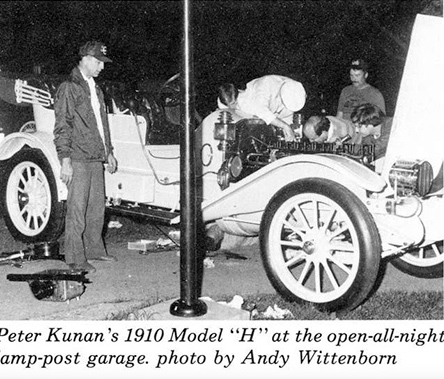
By 1986 the car was owned by Peter Kunan, and while attending the annual 1986 Franklin 'Trek' in Cazenovia, New York, suffered a problem with the engine as described in ACN #98:
Meanwhile, out on the green, Peter Kunan was having his own problems. Trying to start his 1910 Model H Franklin he found a real problem that necessitated dismantling the drive shaft, brake, and transmission to find a retention nut on the crank- shaft and flywheel that had come loose. Many kibitzers gave timely advice and wisecracks 'til the repairs were done. Fortunately it was put back together the next morning.
In an undated letter, Peter Kunan wrote what he knew of the car's history before he owned it, and includes notes on work done to the car during his ownership.
I acquired the car in 1982. It then had an older restoration that was done in the I950s. It was driven that season and then taken apart for restoration. Major highlights of the restoration include the fabrication of new ash frame rails, new 27" wheel rims of a style similar to the originals to replace the 25" demountable wheels which were on the car when purchased, and fabrication of new fenders and cowl. The paint scheme is meant to honor the 1910 custom Torpedo tourings made for Mr. Franklin and Ralph Hamlin. The main color is light gray with pearl trim and striping. The top is dark blue and the upholstery is chocolate brown. At that time, the engine did not undergo a rebuild but was dismantled, cleaned and reassembled with an eye towards ensuring better bearing clearances and replacing the numerous mongrel parts with Franklin parts including such authentic parts as an original Wilkinson carburetor and correct Bosch magneto. The car was then run with excellent results for the 1985, '86, and '87 seasons.
It was not until 1988 that the engine was removed for a total rebuild but for numerous reasons, the work was not completed until 1995. Major engine work included new babbitt bearings on the mains and rods, new pistons and rings, new auxiliary exhaust valves, and static and dynamic balancing of the moving engine parts. Other work was fabrication of a new sheet metal "air deck" and the surrounding side doors, fabrication of all new bolts to duplicate the original Franklin style of hardware, and cosmetic repair of such items as the brass intake manifold and high tension spark plug wire tube. It was at that time the troublesome original drive shaft and u-joints were replaced with a modified Series 11 drive shaft and u-joints with new Spicer replacement joints and transmission brake drum.
After "break-in" the engine performed up to expectations with the highlight coming on a local HCCA tour in which 150 miles were covered in one day without any problems. On the road, the H easily maintains a 40-45 mph pace with a top speed of 55. Shifting is quick and easy with "clutchless" shifts possible between first to second and second to third. Braking is remarkably good using the modified Series 11 set-up.
This car is unlike in style and appearance to the "Barrel hood" offerings from the factory in 1910.
The car's original owner was a man named Edgar Scott. He was a very wealthy individual and a member of Philadelphia's elite "Main Line." According to a fellow who worked for Scott during this time, Scott was intrigued by the Franklin but strongly disliked the round-hooded cars then being made by the Franklin factory. Evidently he ordered a special Model H chassis from the factory. The chassis differs from stock in that it has a 60" tread and a steering column lowered by 13 degrees. Part of the 60" tread modification involves the steering linkage and front axle. The front axle, instead of being one continuous arc, has its ends somewhat flatten out near the steering knuckles. The right front steering knuckle is stamped "Spec." The steering pitman arm and drag link are placed outside the frame instead of inside as on stock models. Likewise, the center section of the cast aluminum toe board has "Special" cast into its back. This piece differs in that it allows for the lower angle of the steering column. The rear axle, by necessity, has longer axle shafts, axle tubings, and related linkages.
Shortly after its completion the car was shipped to Europe where it was toured for nearly a year. If you have ACN #30, there are two letters published in that issue which provide many wonderful details of the car's early years. Its history then blanks out until the 1940s when it was owned by Thomas McKean. Subsequent owners included Henry Austin Clark, Jr., Anthony Kovaleski, and Dr. Daniel Gardner who in the mid-1950s gave it the restoration it had when l purchased it. Dr. Gardner then sold it to M.H. "Tiny" Gould who passed it along to David Tunick. l acquired the car from Tunick early in 1982.
The true origin of the custom design remained muddled until 1985 when I was able to contact the son of the original owner, also named Edgar Scott, of Villanova, Pa. The younger Mr. Scott remembered the car well from when he was a boy, and although somewhat sparse with words, was able to relate to me in two letters that the well known coachbuilder Derham, who was in nearby Rosemont, Pa. was responsible for its striking design. Fellow HHFC member and automotive historian Walt Gosden, who owns a later Derham-bodied Franklin and who researched an in depth article on Derham for Automobile Quarterly, stated he believes this Model His the earliest of Derham's automotive works to exist.
Included with the car are its original windshield and all the necessary parts for installation, however the windshield itself is lacking glass. The main reason the glass has not been replaced in all these years is because I personally much prefer its appearance without the windshield in place and with the top folded. In this configuration the car's striking visual concept is best shown off. Looking at the car from its side and from the front, a "double wedge" is formed when sighted from the rear of the folded top to the front apex of the sloping hood. This style is unlike virtually anything else from the 1910 era which is invariabaly hindered by the necessity of a large, flat-fronted radiator and boxy hood. Without meaning to sound like a Franklin advertisment writer, when seen in the company of a gathering of its non-Franklin comtemporaries, they don't stand a snowball's chance on the auxiliary exhaust manifold after a fifty mile run when it comes to styling. It outclasses everything. Granted, this is all a subjective matter, but rest assured I'm not alone in this sentiment.
Also included are a few extra parts including three cylinders, three unrebuilt Bosch DR6 magnetos, and some various used parts left over from the restoration. I also have two pieces which I believe are from the original car. One is a patent leather half-door which fits between the front left side of the body and the scuttle cowl. This was left out of the restoration because of the lack of necessary hardware and no right side equivalent. In my opinion the fabrication and installation of these half -doors would substantially add to the appearance of the car. The other is a three piece spare tire carrier used on the right running board. This can be seen in the photos printed in ACNs #8 and #30. In contrast to the half-doors, I purposly didn't use the tire carrier in the restoration because it detracts from the flowing body lines too much.
Aura Vincit,
Pete
Peter Kunan
The car was at a number of Franklin 'Treks.'
Now the car is on display at the Franklin Automobile Collection at Hickory Corners located at the Gilmore Car Museum for museum visitors to view and marvel at.
